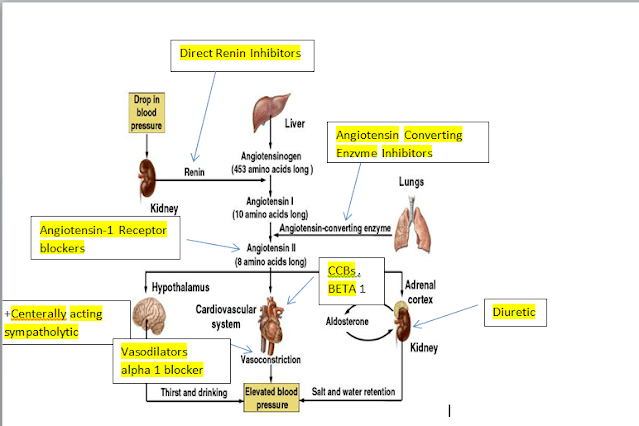Anti-hypertensive drugs
What is hypertension?
Hyper means high and tension means pressure.
Hypertension is also known as high blood pressure so, when blood pressure is increased/higher than normal (which is 120/80 ) we called hypertension.
The other words
" persistent elevation of blood pressure as known as hypertension".
Anti-hypertensive drugs
The drugs that are useful for lower blood pressure as known as antihypertensive
drugs.
There are two types of blood pressure, one is systolic other is diastolic.
When the heart becomes contracts this is called systolic blood pressure.
When heard is relaxed or dilated this is called diastolic blood pressure.
Systolic pressure is 120 mmHg and diastolic pressure is 80 mmHg.
Diuretics
Diuretics are used to eliminate excess salt and water from the body's tissues and blood by the kidneys to reduce blood pressure.
Loop diuretics:
- bumetanide
- ethacrynic acid
- furosemide
- torsemide
Thiazide diuretics:
- epitizide
- hydrochlorothiazide and chlorothiazide
- bendroflumethiazide
- methyclothiazide
- polythiazide
Thiazide-like diuretics:
- indapamide
- chlorthalidone
- metalozone
- Xipamide
- Clopamide
Potassium-sparing diuretics:
- amiloride
- triamterene
- spironolactone
- eplerenone
Calcium channel blockers
Calcium channel blockers are used to block the entry of calcium into muscle cells in artery walls (blood vessels).
dihydropyridines:
- amlodipine
- barnidipine
- cilnidipine
- clevidipine
- felodipine
- isradipine
- lercanidipine
- levamlodipine
- nicardipine
- nifedipine
- nimodipine
- nisoldipine
- nitrendipine
non-dihydropyridines:
ACE inhibitors
Captopril, the prototypical ACE inhibitor
ACE inhibitors inhibit the angiotensin-converting enzyme (ACE) activity, which is released from the Lungs, the angiotensin-converting enzyme responsible for the conversion of angiotensin I into angiotensin II act as a potent vasoconstrictor.
- captopril
- enalapril
- fosinopril
- lisinopril
- moexipril
- perindopril
- quinapril
- ramipril
- trandolapril
- benazepril
Angiotensin II receptor antagonists :
Valsartan, an angiotensin II receptor antagonist.
Angiotensin II receptor antagonists inhibit the activation of angiotensin receptors.
- azilsartan
- candesartan
- eprosartan
- irbesartan
- losartan
- olmesartan
- telmisartan
- valsartan
- Fimasartan
Adrenergic receptor antagonists :
The first beta-blocker to be successfully developed is "Propranolol ".
Beta-blockers
- acebutolol
- atenolol
- bisoprolol
- betaxolol
- carteolol
- carvedilol
- labetalol
- metoprolol
- nadolol
- nebivolol
- oxprenolol
- penbutolol
- pindolol
- propranolol
- timolol
Alpha blockers:
- doxazosin
- phentolamine
- indoramin
- phenoxybenzamine
- prazosin
- terazosin
- tolazoline
- urapidil
Mixed Alpha + Beta-blockers:- bucindolol
- carvedilol
- labetalol
Renin-inhibitors :
Renin which produces from the kidney and converts angiotensinogen into angiotensin- I.
therefore Renin-inhibitors can effectively reduce hypertension.
Aliskiren is only a renin inhibitor that has been using for the treatment of hypertension. it is approved by U.S.FAD.
Vasodilators:
Vasodilators act on the smooth muscle of arteries and reduce constriction of arterial blood walls.
By the dilation of arteries so blood can move more easily through them;
Vasodilators are only used in hypertensive emergencies conditions or when other hypertension drugs have failed to reduce blood pressure, and are rarely given alone.
Sodium nitroprusside,
To regulate hypertension, a very potent, short-acting vasodilator is commonly used for quick, emergency conditions (such as malignant hypertension or aortic dissection).
Hydralazine and its derivatives :
these drugs are not indicated as first-line therapy for hypertension because of their side effects.
but they can use in severe hypertension but avoid emergencies.
Aldosterone receptor antagonist :
Aldosterone receptor antagonists:
Aldosterone receptor antagonists are not used as first-line agents for blood pressure,
But spironolactone and eplerenone are both used in the treatment of cardiac disorders (such as heart failure and resistant hypertension).
Blood pressure regulation pathway with anti-hypertensive drugs.
 |
| Anti-hypertensive drugs classification and mechanism of action |







%20%20for%20Pain%20Relief%20How%20It%20Works%20&%20What%20You%20Need%20to%20Know..png)
%20Effectiveness,%20Safety%20&%20Who%20Needs%20It.png)






2 Comments
Good job. Keep it up and thank u for making our work easy....
ReplyDeletewellcome
Delete